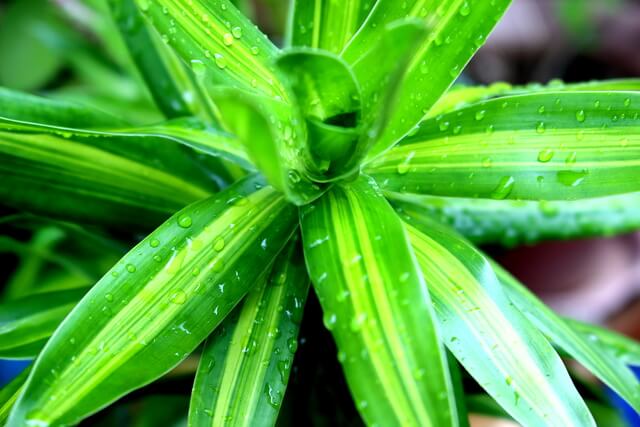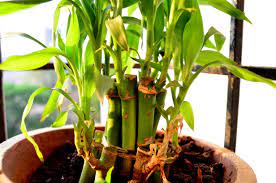Lucky Bamboo scientifically known as Dracaena sanderiana is a popular house plant. Despite of its appearance, lucky bamboo is not a real bamboo. Actually it is more realtaed to a succulent which is a type of grass.
Lucky bamboo is native to Africa. However, it is now planted every where for the sake of good fortune, love, health, growth and treated as a good luck house plant.
This plant is named as lucky bamboo in chinese lore as this plant shows the symbol of good fortune and attracts positive energy. Also there are different meaning for different numbers of stalk.
Coming from the Asparagaceae family, this plant can make your indoor look perfect with its intricate stems and notable resiliency.
Whether you are a beginner or an experienced gardener, this plant can spruce up your indoor greenery with its eye catching shapes, swirls, or braided stalks. So it can be proven as a viable option to plant at your home.
With the stalk that resembles with a true bamboo plant, this houseplant can be grown in a soil or hydroponically.
Although it is a lucky plant from human, it can not be proven lucky to your pet as it is toxic in nature and harm your pets.

Growing of lucky bamboo plant
Growing guide of lucky bamboo plant is quite easy. Following are the steps to grow a lucky bamboo plant at your home.
- Choose a healthy and good plant with bright green leaves. If the stems and leaves are yellow or brown, don’t use it as it is an unhealthy plant.
- Decide how you want to grow the plant whether in water or in soil. If you want to grow it hydroponically, then fill the container with stones and marbles along with water. Stablise and balance it in the bottom for its growth. If you are growing it in soil, then prepare the soil as per the requirements.
- Choose a right spot for the growth of this plant. The right spot for the growth should get bright and filtered sunlight with a temperature between 65 degrees fahrenheit to 90 degrees fahrenhgeit.
- If you growing a lucky bamboo plant hydroponically, then change the water of the container on daily basis. If you are growing it on soil, then water the plant to make the soil moist, not soggy.
- Fertilize the plant if necessary. In the case of soil, direct use of the fertilizer in the soil. If you are growing it hydroponically, then it is recommended to use a liquid fertilizer with diluting it in the water.
Caring guide for lucky bamboo plant
Lucky bamboo plants are fairly easy to take care of. So they are measurably used in homes and offices. The caring guide for this plant is given below:
Sunlight
Lucky bamboo plants don’t require direct sunlight. It requires moderate, indirect, bright, and filtered sunlight that is found under a rainforest canopy.
Direct sunlight can scorch its leaves and turn them brown. So always avoid placing this plant in a place where it gets direct sunlight like in front of a window.
Water
Lucky bamboo does not require too much water, however, it can also grow in water. So if you are growing this plant in water, make sure to change the water of this plant regularly to keep it healthy and happy.
Water with a high level of chlorine and chloride can harm your plant and cause death. So make sure that your water doesn’t contain this stuff. Thus it is recommended to water a lucky bamboo plant with bottled and distilled water.
If you are growing it in soil, then water the plant regularly. Water the plant to make the soil moist and slightly damp, not soggy. Don’t let the soil dry and also don’t overwater.

Soil
The lucky bamboo plant thrives well in a well-drained, rich potting, moist soil.
If you are growing it hydroponically, fill the container with pebbles and marbles with 1 inch of standing water all the time.
Temperature
Lucky bamboo can grow well in warmer climates ranging from 65 degrees Fahrenheit to 90 degrees Fahrenheit. So it is considered a good house plant for your office and home.
But ensure that your plant must not be exposed to the cold draft like an air conditioner, heating vane, a drafty window in winter, etc.
Humidity
Lucky bamboo plant can grow well in a room with average humidity. So don’t stress about increasing or decreasing the humidity of your house.
Fertilizing a house plant is quite necessary. But the lucky bamboo plant does not require a lot of fertilizer. Click To TweetFertilizer
Fertilizing a house plant is quite necessary. But the lucky bamboo plant does not require a lot of fertilizer. A single drop of liquid fertilizer once a month is enough for the growth of this plant.
Dilute the fertilizer before using it as this plant demands a little fertilizer for its growth.

Pruning the lucky bamboo plant
Pruning encourages the growth of more shoots from the cutting area and creates a bushier and denser look. With a little planning and a few choice cuts, pruning is an easy task to perform.
So if you want to prune your lucky bamboo plant, you can cut the thin, long, crookedly growing shoots with a sharp, sterile, pruning shear.
If you want to reshape the plant and give your plant a new look, then you can cut as many shoots you want to cut to flush to the stalk. Due to close cuts, new shoots don’t grow from the pruned areas.
On the stalk of the lucky bamboo plant, you can notice the small clearly defined rings named nodes. While pruning, make sure to cut at this area just above the nodes. The cuts must be smooth and clean in order to minimize the chance of infection. Apart from this node, there is no need to make a cut either in the shoot or in the stalk.
Repotting the plant
The perfect time to repot a lucky bamboo plant is when you notice that the roots are becoming too tight in the container. Once you notice the roots are crowding, move them into a bigger container.
If you are growing the plant hydroponically, then simply move it to a larger vase. dump out the rocks, marbles, and pebbles that you have used in the previous vase and replace them with the newer one.
If you are growing it in the soil, then dampen the soil. Flip the stalks of the plant with your hands, remove the plant, and replace it on a larger pot.

Propagating the plant
In case you want to plant more lucky bamboo plants in your home or you want to gift them to someone, then you can propagate it simply by cutting.
To propagate this plant, identify a healthy stalk with an offshoot and more than two segments.
Clip the offshoot from where it is connected to the parent plant stalk using a aterile, and sharp knife and trim the bottom layer leaves to expose growth nodes and to create a independent stalk.
Replace the new stalk in a new container of water and nurture it properly. Keep the water clean ans safe. It will take 30 days to arise new roots.
After the roots emerged out, put the plant in a vase with soil or a container with water.repot the plants if needed.
Common pests and diseases
Like some other house plants, lucky bamboo is also susceptible to different insect problems and diseases. Some of the common pests that affect lucky bamboo include mites, mealybugs, and different fungus.
If you notice grey fuzz in your plant, then it may be affected by the fungus. In order to cure this, remove the infected growth, and increase air circulation to the plant by keeping the leaves and stalk dry.
If you notice small white insects affecting the plants, then it might be mites or mealybugs. They can be treated by manually picking up by hands or washing the plant with water and liquid dish soaps or by rubbing using alcohol.
If the leaves of the plant is turing brown then it can be caused due to higher chlorine content in the water which can be treated by removing the dead and affected leaves from the plants as well as from the water.
If the leaves are turning yellow, then it may be caused due to exposing into a lot of sunlight and getting a higher amount of fertilizer which can be cured by placing the plant in a shadier place and reducing the amount of fertilizer.






